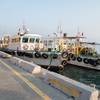Clearwater Collects Data for Stevens' Maritime Lab
Later during the week of June 22, researchers at Stevens Institute of Technology will equip the sloop Clearwater with instrumentation that will provide real-time transmission of position, time, surface water temperature, salinity, and dissolved oxygen concentrations in the northern area of the Hudson River.
The installation is the latest component in the Hudson River Environmental Conditions Observing System (HRECOS), which is operated by a consortium of partners in government and the research community. HRECOS provides data in real-time to allow for the immediate assessment of ocean, weather, and environmental conditions throughout the waters of the Hudson River.
Earlier this year, Dr. Alan F. Blumberg, George Meade Bond professor and Director at Stevens Institute of Technology's Center for Maritime Systems, met with officials from Clearwater, an organization whose goal is to restore and protect the health of the Hudson River watershed.
Clearwater was founded in 1969 by music legend and environmental activist Pete Seeger and the organization began with the launch of sloop Clearwater - a majestic replica of the sloops that sailed the Hudson in the 18th and 19th centuries.
The 106 ft long tall ship was among the first vessels in the U.S. to conduct science-based environmental education aboard a sailing ship, virtually creating the template by which such programs are conducted around the world today.
Stevens and the Clearwater organization will later this week install a sensor on the bow of the sloop. The data collected will be transferred to the Davidson Laboratory at Stevens' campus in Hoboken , N.J. The data will be displayed in real-time on the HRECOS web site (www.hrecos.org). In addition to Stevens, the HRECOS partners currently include Cary Institute of Ecosystem Studies, Lamont Doherty Earth Observatory, Hudson River Foundation, New York State Department of Environmental Conservation and the U.S. Geological Survey. This new sensor will greatly expand the area of HRECOS data collection, which currently runs from roughly Schodack Island to the New York/New Jersey Harbor.
"A successful installation on Clearwater builds upon Stevens' previous work with the sloop Pioneer. The vision is for several mobile sensors thus building a comprehensive network that spans the entire Hudson River simultaneously," said Dr. Blumberg.






